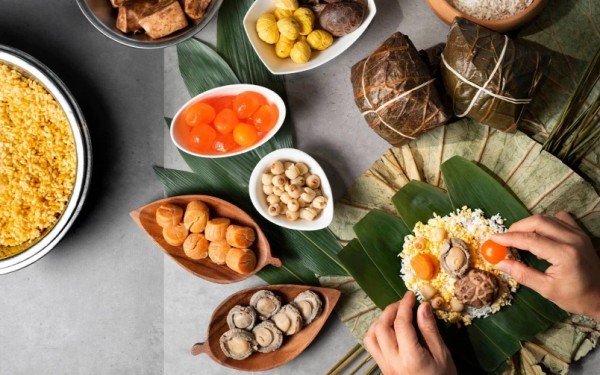The taste bud memory of Guangdong festival: inheritance of food and customs
猫牛呼吸法(Breathing of the Cat and Cow)通过调整呼吸节奏,促进深度睡眠。 #生活技巧# #健康生活方式# #睡眠调整技巧# #瑜伽助眠#
Spring Festival: Cantonese flavor in reunion banquet
The Spring Festival is the most important festival for Guangdong people, symbolizing the hope of reunion and the New Year, and dietary customs play a core role in it. On the Spring Festival dining table in Guangdong, the rich dishes carry the meaning of blessings and auspiciousness. Traditional New Year dishes such as white-cut chicken, steamed fish and potted vegetables reflect Cantonese cuisine’s pursuit of the original flavor of ingredients. The white-cut chicken skin is crispy and tender, which means "starting from scratch", while steamed fish symbolizes "economic surplus every year". The fish body is fully placed, placing it with beautiful expectations for the future.
Pots are a special dish for the Spring Festival in Guangdong, especially in Hong Kong and the New Territories. It stacks abalone, roast goose, mushrooms and other ingredients in large pots, meaning "a lot of money". To make pot vegetables, the ingredients need to be cooked one by one and then carefully stacked, which not only tests the cooking skills, but also shows the rich image of reunion. In terms of desserts, rice cakes symbolize "resurgence every year" with their stickiness and sweetness. Common glutinous rice cakes are decorated with red dates or shredded coconut, which is soft, glutinous and sweet in the mouth.
During the Spring Festival, Guangdong people also have the custom of "New Year's Eve dinner". Friends and relatives sit around a table to share dishes with auspicious meanings. The soup of "fabai" is indispensable on the dining table. The "fabai" is homophonic to "fabai" and expresses the expectation for wealth. This combination of diet and customs not only satisfies the taste buds, but also conveys a strong cultural emotion.
Dragon Boat Festival: The flavor of rice dumplings and dragon boat racing
The Dragon Boat Festival in Guangdong is not only a commemoration of Qu Yuan, but also an important moment to showcase regional food culture. As the iconic food of Dragon Boat Festival, Zongzi presents a unique flavor in Guangdong. Cantonese rice dumplings are mainly made of glutinous rice. Common fillings include salted egg yolks, char siu, mung beans and mushrooms. They are wrapped in bamboo leaves and have a refreshing fragrance after steaming. Guangzhou’s steamed rice dumplings are particularly famous, with large size and rich fillings. The glutinous rice and beans are blended with clear texture and are endlessly savored. The Chaoshan area prefers to add peanuts and chestnuts to add a crispy texture and highlight the local characteristics. Some families will also incorporate yuzu or bacon to give the rice dumplings a richer and fresh fragrance, showing Cantonese cuisine’s pursuit of food diversity. When making rice dumplings, you need to use high-quality bamboo leaves to ensure that the fragrance penetrates. Each rice dumpling carries the hard work of craftsmen.
The process of making rice dumplings is full of ritual. Guangdong families gather together on the eve of Dragon Boat Festival to clean bamboo leaves, soak glutinous rice, and mix fillings. Each step contains respect for tradition. The shape of the rice dumplings is mostly quadrangle or pillow-shaped, which means to ward off evil spirits and health. When making rice dumplings, the family sat together and chatted while making money, which enhanced the family affection and festive atmosphere. Some regions will also use rice dumplings as gifts to relatives and friends to convey holiday blessings. The skills of wrapping rice dumplings vary from family to family. The knot tie and the proportion of filling have become secrets passed down from generation to generation, reflecting the Guangdong people's cherishment of traditional craftsmanship.
The Dragon Boat Festival food customs complement each other with the dragon boat racing. In the Pearl River Delta region, the dragon boat race is the highlight of the Dragon Boat Festival. After the race, there are often community banquets, and the tables are filled with refreshing dishes such as rice dumplings and cold cucumbers, and boiled eggs with mugwort, which means exorcising evil spirits and ensuring safety. Realgar wine will also be prepared in some places, sprinkled in front of the door for peace, adding to the sense of festive ritual. These foods and customs together constitute the unique memory of Guangdong's Dragon Boat Festival.

Mid-Autumn Festival: Mooncakes and sweet reunion
Mid-Autumn Festival is a time for Guangdong people to express reunion and gratitude, and mooncakes are undoubtedly the core delicacy of this festival. Cantonese mooncakes are known for their puff pastry and rich fillings, and common flavors include lotus paste egg yolk, bean paste and five kernels. Lotus paste egg yolk mooncakes are particularly classic. The delicate lotus paste wraps the salty and fragrant egg yolks, which are sweet but not greasy in the mouth, symbolizing the perfection and harmony of the family.
Making Cantonese mooncakes is an exquisite craft. Traditional handmade mooncakes require the dough to be kneaded repeatedly, and the filling is boiled over low heat to ensure a delicate taste. The patterns carved on the mooncake mold, such as the word "Lotus" or "Fu", add to the festive sense of ritual. Guangdong people will also use Pu'er tea or tangerine peel tea to mix the sweetness of the mooncakes with the tea aroma to form a unique taste experience.
The eating customs of the Mid-Autumn Festival are not limited to mooncakes. Some families will add taro buttons to the reunion dinner. The softness of taro and the fat fragrance of pork belly complement each other, meaning "rich and reunion". In addition, Guangdong people will place grapefruits on Mid-Autumn night, which is homophonic to "Youzi" and pray for peace to their descendants. This interweaving of food and culture makes the Mid-Autumn Festival night full of warmth and poetry.
Qingming Festival: A sense of rituals for ancestor worship and festival food
Qingming Festival in Guangdong is a festival that commemorates ancestors and pursues the distance with caution. Food and customs are closely linked to ancestor worship activities. Guangdong people will visit graves during the Qingming Festival, and the food they offer is mostly simple but profound traditional snacks. Aiji is a representative delicacy for the Qingming Festival. It is wrapped in glutinous rice balls with sesame or red bean filling, mixed with the fragrance of mugwort. It has a soft and herbal taste, which means to drive away evil spirits and pray for blessings.
To make wormwood, fresh wormwood is required to boil it, mix it with glutinous rice flour, and knead it into a green dough. This process is not only a display of skills, but also a thankfulness to nature. During the Qingming Festival, Guangdong families will also prepare offerings such as steamed chicken and roast pork, and place them in front of the tomb to express their respect for their ancestors. After offering, the family will share these foods, symbolizing sharing of reunion with their ancestors.
The eating customs of Qingming Festival also include eating seasonal ingredients in spring, such as shepherd's purse or spring bamboo shoots, to make refreshing soup or stir-fry dishes. These dishes not only cater to the atmosphere of spring, but also reflect the keen perception of seasonal ingredients by Guangdong people. Through diet, Guangdong people continue the tradition of worshiping ancestors during the Qingming Festival and express their awe of life.
Double Ninth Festival: Dietary traditions of climbing high and respecting the elderly
Double Ninth Festival is centered on climbing high places and respecting the elderly in Guangdong, while dietary customs add a warm atmosphere to the festival. Chongyang cake is a traditional delicacy for this festival. It is steamed with glutinous rice flour, layered and decorated with red dates or osmanthus flowers, which means "step-by-step rise". Guangdong's Chongyang cake has a soft and glutinous texture and moderate sweetness. It is often shared with your family after climbing high, symbolizing reunion and longevity.
When making Chongyang cake, you need to pay attention to the heat and proportion. The combination of glutinous rice flour and sugar water should be just right to ensure that the pastry is soft and not sticky. Some families also sprinkle sesame or shredded coconut on the pastry to add aroma. During the Double Ninth Festival, Guangdong people will also prepare a banquet for the elderly. The dishes are mainly light, such as scalloped shrimp and steamed pork ribs, reflecting their care and respect for the elderly.
After the climbing activity, the family often gathers together to enjoy seasonal fruits, such as persimmons and chestnuts, which means "everything goes well." These dietary customs not only enrich the connotation of Double Ninth Festival, but also convey good wishes for longevity and family harmony through food.
Cultural integration between diet and festivals
Guangdong's festival food is not only a feast for taste, but also a cultural heritage and expression. Behind every festive delicacy, there is profound symbolic meaning and historical accumulation. The stickiness of rice cakes represents reunion, the wrapping of rice dumplings means health, and the roundness of moon cakes symbolizes perfection. These delicacies convey the spirit of the festival to every diner through taste and form.
Food customs also carry the Guangdong people’s awe of nature and the wisdom of life. Whether it is the Aiji on the Qingming Festival or the chestnut on the Double Ninth Festival, Cantonese festival delicacies are mostly seasonal ingredients, reflecting the harmonious coexistence between man and nature. At the same time, the production process of these delicacies often requires the joint participation of family members, which enhances the cohesion of family affection and community.
In today's globalization, Guangdong's festival food culture is also constantly spreading. Overseas Guangdong immigrants brought rice cakes, rice dumplings and mooncakes to all over the world, not only retaining the traditional flavor, but also integrating local characteristics, such as mooncakes that add coconut milk flavor to Southeast Asia. This cross-cultural communication has made Guangdong's festival food a cultural link connecting the global Chinese community.
网址:The taste bud memory of Guangdong festival: inheritance of food and customs https://www.yuejiaxmz.com/news/view/1105971
相关内容
Guizhou Cuisine: Hot Spicy Food and the Top 10 DishesProgress of the Role of Probiotics in the Prevention and Treatment of Allergic Diseases
The impact of vegan life on us! The more vegan, the healthier!
The impact of vegetarian life on us, the more vegetarian the healthier
The cultural revival of second
食品SCI期刊介绍- JOURNAL OF FOOD SCIENCE AND TECHNOLOGY
Guangdong Airbaker New Material Co., Ltd.
A study on the influencing factors and relative contribution of family on children's health: From the perspective of household production of health
Lesson 1: Mastering the Essentials of Culinary Skills
Research progress in the relationship between gut microbiota and food allergy in children

